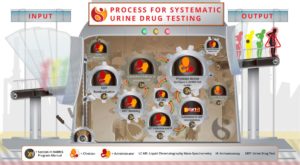figure2
The HARMS UDT system effectively refines the estimate of risk/benefit balance with each iteration of the process. The process, as demonstrated here, was structured so that most of the cogs in the system would fall under the responsibility of clinical administrators. This offloads responsibility, where possible, from busy clinicians. When a patient enters HARMS for the first time, the name and risk category are added to a HARMS Patient Master List. Patients are then randomly selected from that list for UDT at a rate concordant with risk. Once selected, the patient is then notified of a UDT appointment at the clinic in the next 36 hours. UDT is then collected and analyzed using immunoassay (IA). START-IT automatically interprets the results within the limitations of the test. The physician is then notified of the UDT IA result and interpretation, while awaiting confirmatory testing results as applicable. If the patient is rand-omized and does not provide a UDT for whatever reason (unable to contact, no-show, cancellation, unable to urinate, etc.), then the patient stays on a “recall list” until the UDT is provided. If despite repeated attempts, the patient continues to not provide a sample, then the physician is notified by clinical administration. The information from the UDT process (results themselves, or a failure to provide UDT) is then used as the physician considers taking action. The HARMS Patient Master List is then updated with any changes to the risk level. If the opioid prescription is continued for chronic pain then the patient will re-enter the cycle with the updated risk level.

